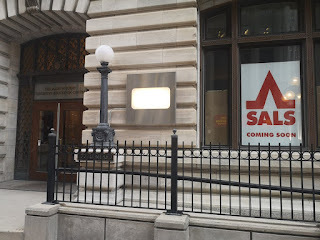Once upon a time the University was one block square. Portage Avenue was it's beautiful face although for years it was a bit crumbly despite green verdant land right to the street. Balmoral was one tough border street with belching buses idling at the station and and even toughener Mall Hotel with seemed to be a permanent police presence right through to the 1980s. Furby Street was greener and a had a few private apartments where students stayed and older residence that were slowly decaying, one filled with dozens of cats. The rump end of it all was Ellice where Lockhart hall rose high up to the street but unlike the front of the campus had no curbside appeal despite it being one of the newest part of the campus.
Welcome to the 1980s. The building phase of the University of Winnipeg in the 1960s and 1970s was over. The decade of cuts began even as student enrollment began. Classes were cut, programs cut. Men's hockey team...gone. Men and women's residences...shut down. They became offices since there was no budget for new infrastructure. Infrastructure was aging every year, tuition going up and a recession was smacking Winnipeg harder that anything since the Depression.
Despite all this University of Winnipeg coped, had excellent instructors and and enjoyed a strong reputation even as students had to attend a year or two more to get the courses they needed because of aid cuts, tuition cuts and courses that were not offered the year a student wanted and needed them.
The University of Winnipeg's sports facilities might have been the worst in Canada, Riddell Hall basement where the school volleyball and basketball teams shocked rivals across North America was a disaster. For a dozen years the university begged for funding but everything was frozen in 1977. It was only in 1982 that a new government allocated spending of over $8 million for what became the Duckworth Centre. The University of Winnipeg Student's Association was so committed to the new building that they allocated money from students via a vote.
Flash forward to 2018 and the U of W has spread across four blocks and more of the city. It has seen the return of student residences, one of the largest downtown daycare centers, restored facades and re-construction of Wesley Hall and top notch Collegiate, a science building, enhanced student dining, better bookstore and and grown its programming and student services. It isn't perfect but until 1984 when the athletic fieldhouse was built, the university was in decline.
There have always been businesses near the university that students patronized but there was no student bar per se. Students and faculty sometimes went to the Union Centre down the street for cheap beer. A close by Legion served the same purpose. But it was haphazard and was not truly a center of student life. The three main cafeterias on the one block campus is where people ate and then left.
As for stores, there were a few across the street like Mother's Music that students went to the 1980s. Supreme Racquet Courts also had students who were members played but campus life was such that very few actually lived in the area. As a result, nightlight was quiet in the proximate area of the university.
This has changed with students living downtown and the numbers keep growing. I will save the discussion about south of Portage Avenue for later. For now, let us focus on north Portage surrounding the university, specifically the west side.
The stretching out of the campus along Portage west has begun a transformation of the street.
To be fair, business has been on the street for eons catering to local neighbourhood and ethnic communities, However, what we are seeing now are changes that seem to reflect that students don't just come to school for classes but live in the neigbourhood.
The stretch of street along the southside of Portage Avenue between Young and Langside would appear to affected by changes in the campus now surrounding them. Some businesses have been there for decades but other are popping up to serve the university. Take the case of Langside where some tiny businesses such as book store, hair salon and a restaurant have set up opposite Richardson Science Hall and McFeetors Hall.
Arzate Hair Salon, Elemental Book and Curiosity Ship and the new Not A Waffle (replacing Yo Tea) sit small and pretty across from the university. Just on Portage itself in the same building is a convenience store, nightclub and most importantly for students, a cellular phone store.
It takes a while for a neighbourhood to change organically. It can come in stops and starts but the presence of a local population and one not prone to a bunker mentality to change things.
Without a doubt, the move of the University of Winnipeg westward down Portage Avenue is changing thing. Further down the street in the block after the science complex, the Good Will restaurant and entertainment space would seem to be a good example of the change we can expect a larger student population can bring.
Everyone will have to keep an eye out for how things are being transformed on what once was a commuter campus.





















































